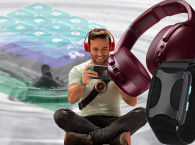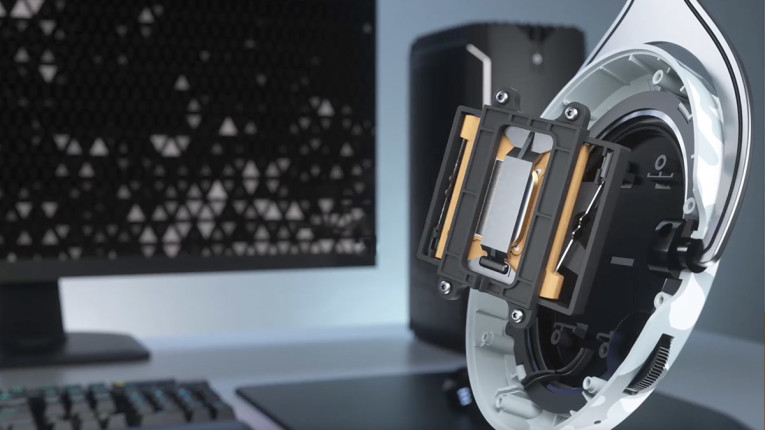
Engineers and audiophiles talk about the spectrum of sound as spanning 20Hz to 20,000Hz. That’s only partially correct. Most adults can’t hear above 14kHz. More importantly, humans in general don’t actually hear 20Hz very well either. But everyone — the deaf and hearing alike — can feel 120Hz and 20Hz, and even lower. In fact, “hearing” deep bass is mostly feeling it.
Bass perception happens along an audio-tactile spectrum. The lowest notes are sensed primarily with the skin, and the highest primarily with the ear, but all of them are naturally perceived as a mix of both senses. That’s a big part of the reason why it is so hard to get that “live sound” feeling with headphones — normal headphones can’t produce a critical aspect of the live experience.
Does frequency response down to 30Hz, 20Hz, and below matter? The answer is “yes.” Rock, hip-hop, and EDM have huge amounts of energy at those levels.
Jazz and orchestral music, plus movies and games do, too. If you’ve never heard your favorite music on a system that can reproduce ALL the frequencies that are present in the recording, you will probably be shocked to learn how much you have been missing.
So how can you get deep bass? Producing low-frequency acoustic sound at high volumes means moving a lot of air. A good home theater subwoofer can have drivers that are 15” or more in diameter. A PA system for a stadium concert can have hundreds of them.
When those giant speakers crank up, you don’t just hear them — you feel them. Your skin vibrates. Your organs vibrate. And (for most people) your brain interprets that vibration as sound, even though it mostly isn’t being processed by what you normally think of as hearing.
Perceiving music is like perceiving food. We talk about tasting food, just as we talk about hearing music. But your sense of smell is an essential component of the enjoyment of a good meal. If you have a cold or your sense of smell is damaged, food becomes bland and uninteresting. Just as the input from your nose makes a steak or a fine wine more of a sensory delight, the experience of feeling the bass is what makes going to a concert or dance club so much more powerful than listening to the same music with only your hearing.
Conventional headphones can’t deliver that experience — they’re like drinking a Cabernet while holding your nostrils closed. (The vast majority of home and car stereo speakers can’t do it either, for that matter.)
Audio drivers in most headphones are (at most) only 1” to 2” in diameter. Some headphones claim to be able to produce sound down to 20Hz. They might even measure acoustically “flat.” But your ears are very insensitive to deep bass. For a 15Hz sound to be perceived as equally loud as a 75Hz sound, it has to be 30 times louder — loud enough to quickly cause serious hearing loss, in fact. So headphones that measure “flat” aren’t perceived as flat (Figure 1).
On the other hand, the human sensory system is extremely sensitive to touch. And it is very sensitive to vibration in exactly the frequency range where hearing lets us down. So a 15Hz signal applied to the skin (depending on the part of the body) only needs velocity 2x higher than one at 75Hz to seem equally strong. The Figure 2 graph shows touch versus hearing sensitivity and looks a lot like a crossover between a subwoofer and a satellite speaker, doesn’t it?
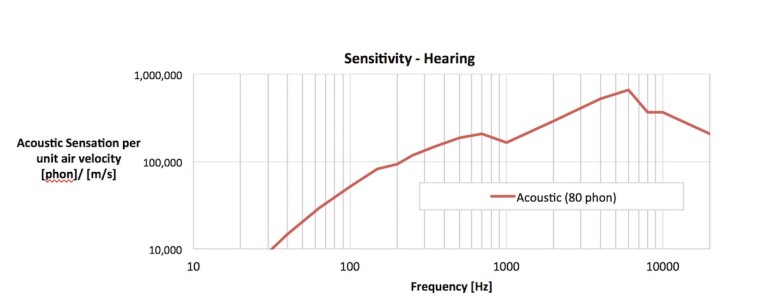
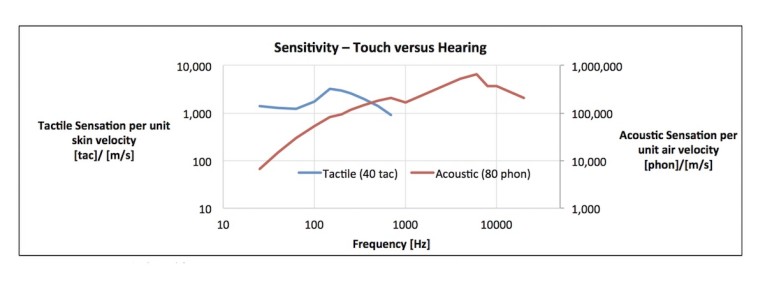
Doing Haptics with Sound
When integrated into an over-ear headphone, the Taction Transporter complements the main audio driver by vibrating the skin to produce deep bass. It does this by subtly moving the cushions of the headphones against our head.
It seems simple, but if done wrong, that movement creates a bunch of problems. Other headphones have tried to do this before, with disappointing results. One problem is that their transducers weren’t as good as Transporters. (More about that later in the article.)
How you move the cushions matters too. Most tactile bass transducers to-date have tried to move the headphone cup on the same axis as the audio transducer works, which means moving the headphone cup toward and away from your skull. Moving the earcups this way usually causes serious issues with the frequency response of the acoustic driver, because it dynamically changes the volume of air inside the earcup.
Taction Transporters work differently. The transducers move the headphone cups in the sagittal plane–that is front-to-back along the surface of the skin (Figure 3). With this approach, distortion is dramatically reduced. It is also a more efficient way to transmit vibration to your skin. In a properly tuned headphone, Transporters give you epic, subterranean bass without screwing up the acoustic response. But none of that would matter if our transducer wasn’t the most powerful, flattest tactile driver ever produced.
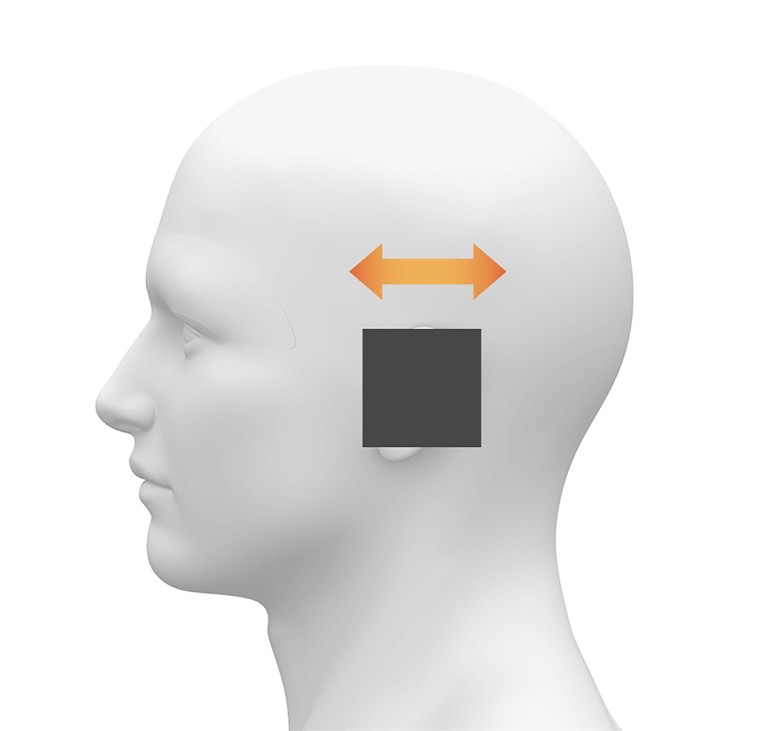
Why Flat Frequency Response Matters
How loud should that note be? Musicians and sound engineers try hard to get every sound recorded at just the right level. If your speakers or headphones aren’t flat, you hear something different from what they intended. (Note: There is some debate about what the ideal perceptually flat response is for headphones but the disagreements are pretty minor.) Flat frequency response matters for tactile drivers, too.
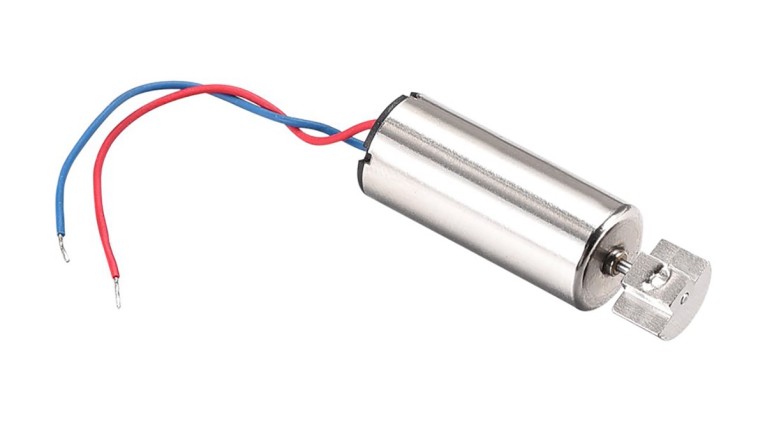
It’s pretty easy to make a low-fidelity tactile bass driver. So some folks have offered headphones that use eccentric rotating mass (ERM) motors (Photo 1). ERMs have been used for years to make cellphones vibrate in silent mode.
A few companies have used them in things like game controllers and headphones (Figure 4). While they can produce a range of frequencies, they have a major limitation: There is a fixed relationship between frequency and given power output. If you want it to go louder, it has to rotate at a higher frequency. If you want it to play a lower frequency, it has to get quieter.

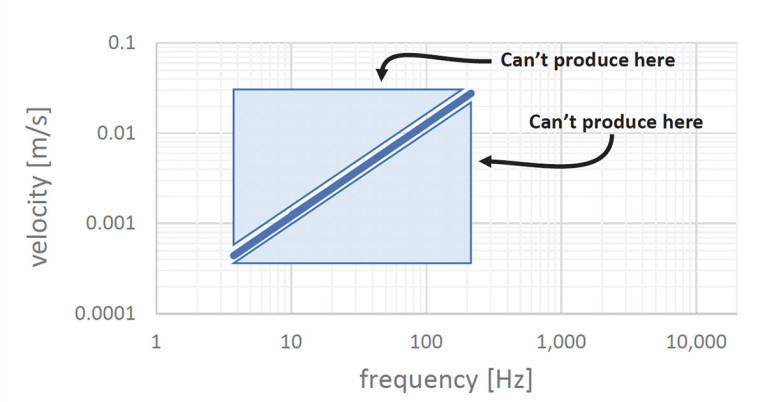
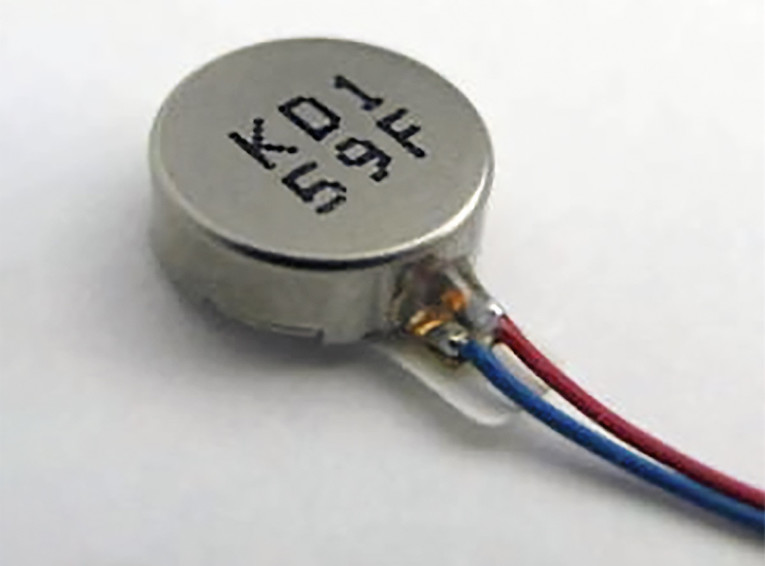
ERMs can only produce output along a single line — there is no “area under the curve.” So the range of possible outputs from an ERM is quite small, and the effect won’t sound much like music for most program material (Figure 5).
Another type of device that’s been tried in headphones and other devices, including seat-mounted rumblers, is called a Linear Resonant Actuator (LRA). Like ERMs, these can be small and inexpensive (Photo 2). But also like ERMs, they are incapable of delivering high-fidelity bass response. The biggest problem with LRAs is in the name: resonance.
Speaker and headphone designers work hard to eliminate (or at least compensate for) resonances so they don’t color the sound. LRAs, on the other hand are all about resonance. That makes them very efficient at playing a single note. If an LRA resonates at middle C on a piano, it can play middle C very loud with very little power. But C sharp will be barely audible, as will B natural. And that’s all folks — all the other notes on the piano will be inaudible (Figure 6).
Some LRAs used in headphones are so resonant that they ring like crazy if you just tap the cup of the headphone with your finger — even when the headphones aren’t plugged in.
So how do Transporters compare to LRAs and ERMs? Let’s start by comparing them in terms of frequency response (Figure 7). Taction Transporters are flat ±4dB from 15Hz to 85Hz. They can produce output at any level from the threshold of perceptibility up to actually blurring your vision at any of those frequencies. Wide frequency response is critical to good tactile performance. But that’s only one of several important parameters.
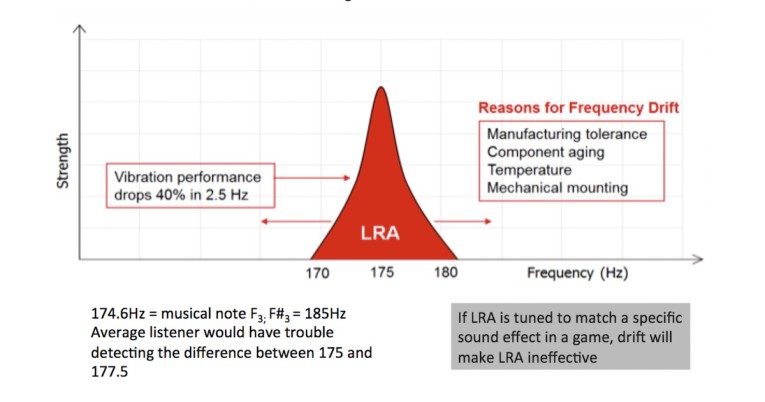
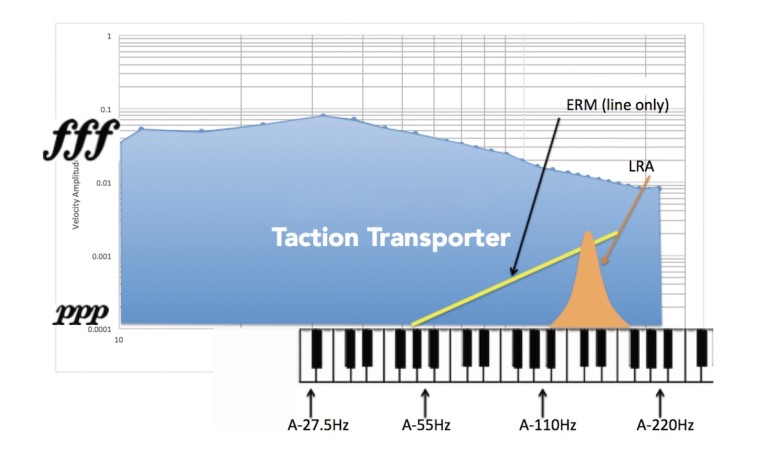
Power That Doesn’t Corrupt
As previously discussed, your skin includes sensitive receptors for tactile signals. But there is a threshold below which those signals will go unnoticed. If a headphone manufacturer goes to all the trouble and expense of adding tactile transducers to a pair of headphones, the system had better be capable of producing enough tactile output to be felt.
There are several different ways of measuring power as delivered by a tactile transducer. (Headphone designers, take note: Your head-and-torso simulator will not properly measure tactile output. Tactile transducers don’t (intentionally) produce changes in air pressure.) Taction offers dedicated test equipment based on three-axis accelerometers to measure tactile output.
You can measure tactile output as acceleration, as velocity, or as displacement. The measurement that best correlates with user experience, in our opinion, is velocity. A transducer that delivers constant velocity over a given frequency range will be perceived by a user as providing flat frequency response.
So how much velocity is required? The threshold for perception of a tactile signal varies from person to person, and is different for different parts of your body. But a good baseline is 5 mm/second.
The ERMs and LRAs used in other headphones that claim tactile output are severely challenged on this score. The LRA used in one well-known headphone produces a tactile signal above the perceptual threshold only around the resonant frequency. Unfortunately, when it’s doing this, acoustically it loudly rings like a bell at about 75Hz.
An ERM could theoretically deliver strong output at the top end of its frequency range, but (a) as previously discussed, the only way to increase the output of an ERM is to increase its frequency, which obviously doesn’t deliver flat output; and (b) the ERMs commonly used just aren’t that powerful. In a typical headphone, the Transporter can deliver at least 5mm/s of earcup velocity from 13Hz to above 100Hz.

The Need for Speed
Audio drivers with quick rise and fall times make music sound more dynamic, but rise time is especially important for gaming. Saving a few milliseconds of reaction time can mean the difference between killing and being killed. There’s research that shows that your body actually processes tactile inputs faster than audio inputs.
But a faster path from skin to brain to action does no good if it takes forever for the signal to become strong enough to reach your skin’s perceptual threshold.
Fast rise time is key. Fast fall times matter, too. Three aspects of transducer design are critical to achieving quick rise and fall times: power, mass, and damping.
ERMs have long rise times — on the order of 150 milliseconds or more. LRAs rise faster than ERMs, but only at their resonant frequency. At other frequencies the rise time is effectively “never.” Even so, it takes many cycles for an LRA to generate enough oomph to deliver its strongest output. That’s because they tend to have a lot of mass relative to the power of their motors. Transporters are a very different story (Figure 8).
The LRA takes about 160 milliseconds to reach 90% of its potential output. That kind of delay is easily noticeable. (Audio-tactile mismatch gets noticeable when its around 40 milliseconds or larger.) That’s bad for music. It’s even worse for gaming.
By comparison, a headphone, driven by a Taction Transporter can reach 90% of its potential tactile output in just 8 milliseconds. That means the audio and tactile perceptions feel properly synchronized.
So how did we create a tactile transducer with strong output and fast rise times? As Newton figured out, force requires acceleration and mass. Taction brings plenty of both.
To be effective, tactile transducers need to have mass — significantly more mass than other tactile transducers have used. The Transporter’s moving mass weighs 18 grams. That’s 3 to 10 times more mass than you would find in previous comparable transducers.
To make that mass move quickly, we also need some serious acceleration and that requires a powerful motor. The motor in the Transporter is more powerful than the motor used in any other current tactile headphones we know of and 10 times stronger than the most powerful potentially usable ERM we know of (Figure 9).
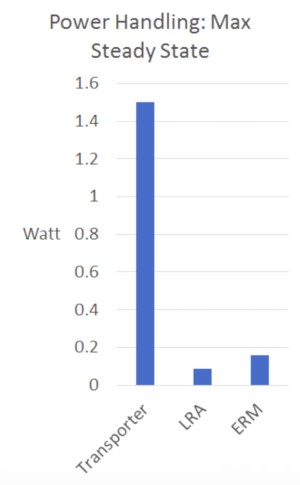
More mass, plus more acceleration, equals more force. Enough force (at the highest setting) to literally blur your vision. (While most of us might not want that, some folks do, and it provides abundant, low-distortion headroom for the rest of us.) It also makes Transporter transducers viable for a number of other applications outside the context of headphones.
The third critical factor in building a responsive transducer is damping. Damping resists movement. There are many ways to do this, and the properties of damped systems can be very complex.
For purposes of our tactile transducer, you can think of damping as a method for (a) reducing resonances and (b) helping the transducer stop moving, which improves fall times. Transporters use patented damping techniques that give unprecedented control, and excellent rise and fall times (Figure 10).
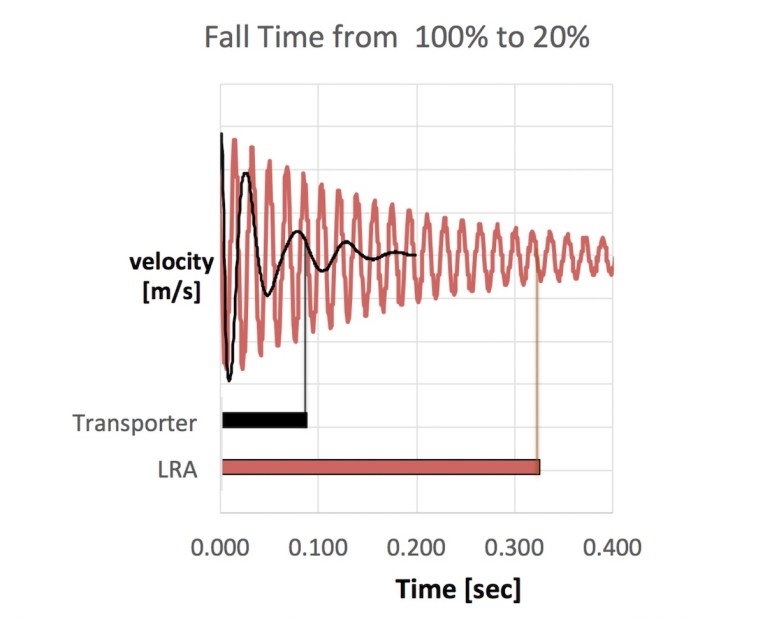
That kind of fall time is critical to reproducing music, and to making sure that sounds like explosions get out of the way of other important cues in gaming. The result, enables the Transporter transducers to offer dramatically improved transient response compared to all previous attempts at using tactile transducers in headphones.
The Most Advanced Transducer
From the extensive research conducted by Taction, we can finally describe the characteristics of the ideal tactile transducer (Photo 3):
Equally strong at all relevant frequencies — from as low as 10Hz to as high as 100Hz or so Able to produce any frequency in that range at any output level—loud, soft, or anywhere in between Starts and stops on a dime Already implemented in commercially available products, such as the Corsair HS60 Haptic Stereo Gaming Headset, Taction now sells off-the-shelf haptic motors or offers a manufacturing license agreement. The published specifications for the Transporter transducer detail the ability to reach the lowest tactile bass note of 12Hz with a velocity of 5mm/s, and reach the highest tactile bass note of 120Hz at that same velocity. Rise time is only 0.008 seconds, and fall time 0.090 seconds. The transducer is able to move the headphones’ earcups with a top speed of 50mm/s with minimal impact on headphone acoustics. The intensity is adjustable, maintaining a flat frequency response between 15Hz to 85Hz (±4dB).

Overall Conclusion
We believe the Transporter haptic transducers are able to offer an unmatched deep bass sensation. They are fast, with an instant start and no lag, and they stop instantly, with no ringing.
The simple electronics enable systems using standard audio components. More importantly, the Transporters are quiet, and extend the high-fidelity frequency response all the way to 250Hz. aX
Resources
Corsair HS60 Haptic, Stereo Gaming Headset with Haptic Bass, www.corsair.com
dB Enterprises, www.db-ent.com (Sales Contact for Taction: Dave Lindberg (lindberg@db-ent.com)
Taction Technology, www.tactiontechnology.com
About the Authors
 Silmon James Biggs, Ph.D, is the founder and CTO of Taction Technology, and the inventor of the Taction Transporter haptic transducer. A full-stack tech guru, from mechanical design and digital circuits to software and everything in between, James invested years in finding better ways to interface people with technology. Fascinated by the tactile aspect of sound since he was a kid, it drove him to study human biology at Stanford, and do postdoctoral research at the MIT Touch Lab, including work for DARPA on man-machine interfaces. He also helped develop electroactive polymer transducers for Artificial Muscle, Inc.
Silmon James Biggs, Ph.D, is the founder and CTO of Taction Technology, and the inventor of the Taction Transporter haptic transducer. A full-stack tech guru, from mechanical design and digital circuits to software and everything in between, James invested years in finding better ways to interface people with technology. Fascinated by the tactile aspect of sound since he was a kid, it drove him to study human biology at Stanford, and do postdoctoral research at the MIT Touch Lab, including work for DARPA on man-machine interfaces. He also helped develop electroactive polymer transducers for Artificial Muscle, Inc. John Steinberg is the CEO of Taction Technology, founding CEO of EcoFactor, Inc., a pioneer in the Internet of Things, Big Data, and the Smart Home. John is a Silicon Valley, CA, veteran and a former musician (Berklee College of Music, Oberlin Conservatory). He worked in high-end stereo stores as a teenager and as an adult, treasures his 700+ LPs and vintage audio gear, some of which date back to the 1950s. John has also been issued more than 50 patents.
John Steinberg is the CEO of Taction Technology, founding CEO of EcoFactor, Inc., a pioneer in the Internet of Things, Big Data, and the Smart Home. John is a Silicon Valley, CA, veteran and a former musician (Berklee College of Music, Oberlin Conservatory). He worked in high-end stereo stores as a teenager and as an adult, treasures his 700+ LPs and vintage audio gear, some of which date back to the 1950s. John has also been issued more than 50 patents.This article was originally published in audioXpress, January 2023.




